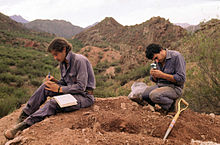Recording (geology)

The geological recording is the recording and documentation of the geological conditions (including the type and storage of rocks ) at a specific location or in a specific region of the world. As a rule, the recording is made in natural or artificial outcrops in the area, sometimes also on the basis of drill cores or borehole measurements. The recording geologist traditionally uses a field book to record , usually combined with a camera , but now also modern technology such as dictation machines or smartphones . Typical equipment for measuring quantitative terrain data is a tape measure or folding rule and a geological compass . Qualitative rock features are determined on site using sensors, often with the help of a magnifying glass. The for the pending rock body - z. B. with the help of a geologist's hammer - samples taken or collected in the talus can be taken with you and, if necessary, subsequently examined and determined in more detail in the laboratory using modern analysis technology ( spectrometry , diffractometry ) or in the form of thin sections under a polarizing microscope .
The recording can be short-term and punctual and include, for example, the recording of the sequence of layers of sedimentary rocks in a single larger outcrop (a so-called profile recording ) or a single drill core ( drill core recording ). However, it can also take place over a longer period of time (several weeks to many years) using numerous systematic point-to-point recordings distributed over a larger area (up to several tens of thousands of square kilometers). Local recordings can be used, for example, as the basis for building site reports or a paleontological excavation . Spatially extended recordings are mostly used for geological mapping of the corresponding area, which in turn z. As a basis for exploration on mineral resources can be.
swell
- Helmut Herrmann, Herbert Bucksch: Dictionary GeoTechnik / Dictionary Geotechnical Engineering. Springer-Verlag, 2014, ISBN 978-3-642-33335-4 , p. 451